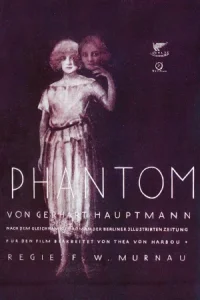Shadows of Despair: How F.W. Murnau's 'Phantom' (1922) Weaves a Haunting Tale of Obsession and Illusion!
In the golden age of German Expressionist cinema, F.W. Murnau stands as a towering master, a director whose films transcended mere storytelling to become profound explorations of the human psyche, often steeped in dark romanticism and visual poetry. Before his iconic vampire masterpiece Nosferatu (1922) and his Hollywood triumph Sunrise (1927), Murnau delivered Phantom (1922), a lesser-known but equally compelling work that showcases his genius for psychological drama and visual metaphor. This film isn't a supernatural horror; it's a deep, haunting dive into the devastating power of obsession, illusion, and the fragile line between fantasy and reality. It subtly foreshadows many of the themes and visual techniques that would define his later, more famous films, cementing its place as an important, albeit often overlooked, gem in his illustrious filmography and a crucial piece of German Expressionist art.
The film plunges us into the tragic downward spiral of Lorenz Lubota (Alfred Abel), a humble and idealistic municipal clerk whose ordinary life is shattered by a chance encounter. While walking home, he is almost run over by a carriage, and in a fleeting moment, catches sight of its beautiful passenger. This brief glimpse, imbued with the power of unfulfilled desire, quickly transforms into an all-consuming obsession. Lorenz projects all his hopes and dreams onto this mysterious "phantom" woman, gradually losing his grip on reality as his infatuation drives him to neglect his work, abandon his loving fiancée, and ultimately descend into a desperate spiral of financial ruin, crime, and madness. The film meticulously charts his psychological disintegration, showing how an innocent fantasy can become a destructive force, blurring the lines between what is real and what is merely a projection of a tormented mind.
F.W. Murnau's directorial brilliance is evident in every frame, utilizing the full expressive power of German Expressionism to convey Lorenz's internal world. The cinematography is masterful, employing distorted perspectives, stark lighting, and dreamlike sequences to visually represent Lorenz's subjective, unraveling reality. Murnau skillfully uses long takes and fluid camera movements to immerse the viewer in the protagonist's psychological state, making the audience feel his growing obsession and despair. Alfred Abel (also known for his role in Metropolis) delivers a haunting performance as Lorenz, conveying his character's quiet desperation and ultimate madness with profound nuance, carrying the film's intense psychological weight. The film is a silent masterpiece, relying entirely on visual storytelling and the actors' expressions to communicate its complex emotional and thematic landscape, proving Murnau’s unparalleled skill in crafting deeply human, often tragic, dramas.
Director: F.W. Murnau.
Cast: Alfred Abel as Lorenz Lubota, Grete Berger as Baronin, Aud Egede-Nissen as Veronika, and Lil Dagover as Marie Starke.
Special Info/Trivia: The film is based on the 1922 novel Phantom by Gerhart Hauptmann. F.W. Murnau directed this film in the same year as his iconic vampire film Nosferatu. Alfred Abel would later star as Joh Fredersen in Fritz Lang's Metropolis (1927). The film is a significant example of German Expressionist cinema, utilizing distorted visuals and subjective perspectives to reflect psychological states. Despite its critical acclaim, it suffered from financial difficulties during production, a common challenge for many German Expressionist films.

